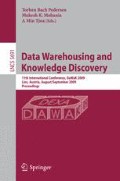Abstract
We investigate the problem of finding frequent patterns in a continuous stream of transactions. In the literature two prominent approaches are often used: (a) perform approximate counting (e.g., lossy counting algorithm (LCA) of Manku and Motwani, VLDB 2002) by using a lower support threshold than the one given by the user, or (b) maintain a running sample (e.g., reservoir sampling (Algo-Z) of Vitter, TOMS 1985) and generate frequent itemsets from the sample on demand. Both approaches have their advantages and disadvantages. For instance, LCA is known to output all frequent itemsets (recall = 1) but it also outputs many false frequent itemsets (low precision). Sampling is fast, but it outputs a large number of false itemsets as frequent itemsets, particularly when sample size is not large. Although both approaches are known to be practically useful, to the best of our knowledge there has been no comparison between the two approaches. In addition, we propose a novel sampling algorithm (DSS). DSS selects transactions to be included in the sample based on histogram of single itemsets. An empirical comparison study between the 3 algorithms is performed using synthetic and benchmark datasets. Results show that DSS is consistently more accurate than LCA and Algo-Z, whereas LCA performs consistently better than Algo-Z. Furthermore, DSS, although requires more time than Algo-Z, is faster than LCA.
Access this chapter
Tax calculation will be finalised at checkout
Purchases are for personal use only
Preview
Unable to display preview. Download preview PDF.
References
Goethals, B.: Survey on frequent pattern mining (manuscript) (2003)
Manku, G., Motwani, R.: Approximate frequency counts over data streams. In: VLDB, pp. 346–357 (2002)
Misra, J., Gries, D.: Finding repeated elements. Scientific Computing Programming 2(2), 143–152 (1982)
Karp, R.M., Shenker, S., Papadimitriou, C.H.: A simple algorithm for finding frequent elements in streams and bags. ACM Transactions on Database Systems 28(1), 51–55 (2003)
Calders, T., Dexters, N., Goethals, B.: Mining frequent itemsets in a stream. In: Perner, P. (ed.) ICDM 2007. LNCS, vol. 4597, pp. 83–92. Springer, Heidelberg (2007)
Cheng, J., Ke, Y., Ng, W.: A survey on algorithms for mining frequent itemsets over data streams. An International Journal of Knowledge and Information Systems (2007)
Cheng, J., Ke, Y., Ng, W.: Maintaining frequent itemsets over high-speed data streams. In: Proceedings of the 10th Pacific-Asia Conference on Knowledge Discovery and Data Mining, pp. 462–467 (2006)
Giannella, C., Han, J., Pei, J., Yan, X., Yu, P.: Mining frequent patterns in data streams at multiple time granularities. In: Kargupta, H., Joshi, A., Sivakumar, K., Yesha, Y. (eds.) Next Generation Data Mining, pp. 191–212. AAAI/MIT (2003)
Ng, W., Dash, M.: Efficient approximate mining of frequent patterns over transactional data streams. In: Song, I.-Y., Eder, J., Nguyen, T.M. (eds.) DaWaK 2008. LNCS, vol. 5182, pp. 241–250. Springer, Heidelberg (2008)
Toivonen, H.: Sampling large databases for association rules. In: VLDB 1996: Proceedings of the 22th International Conference on Very Large Data Bases, pp. 134–145 (1996)
Mannila, H., Toivonen, H., Verkamo, A.I.: Efficient algorithms for discovering association rules. In: Fayyad, U.M., Uthurusamy, R. (eds.) AAAI Workshop on Knowledge Discovery in Databases (KDD 1994), pp. 181–192 (1994)
Zaki, M., Parthasarathy, S., Li, W., Ogihara, M.: Evaluation of sampling for data mining of association rules. In: Seventh International Workshop on Research Issues in Data Engineering, RIDE 1997 (1996)
Yu, X., Chong, Z., Lu, H., Zhou, A.: False positive or false negative: Mining frequent itemsets from high speed transactional data streams. In: Int. Conf. on VLDB (2004)
Kohavi, Z.Z.R.: Real world performance of association rule algorithms. In: ACM SIGKDD (2001)
Vitter, J.: Random sampling with a reservoir. ACM Transactions on Mathematical Software 11, 37–57 (1985)
Chen, B., Haas, P.J., Scheuermann, P.: A new two-phase sampling based algorithm for discovering association rules. In: KDD, pp. 462–468 (2002)
Bronnimann, H., Chen, B., Dash, M., Haas, P., Scheuermann, P.: Efficient data reduction with ease. In: Proceedings of ACM SIGKDD International Conference in Knowledge Discovery and Data Mining, pp. 59–68 (2003)
Chuang, K.-T., Chen, M.-S., Yang, W.-C.: Progressive sampling for association rules based on sampling error estimation. In: Ho, T.-B., Cheung, D., Liu, H. (eds.) PAKDD 2005. LNCS, vol. 3518, pp. 505–515. Springer, Heidelberg (2005)
Kubica, J., Moore, A.: Probabilistic noise identification and data cleaning. In: Proceedings of International Conference on Data Mining, ICDM (2003)
Zhu, X., Wu, X., Khoshgoftaar, T.M., Shi, Y.: Empirical study of the noise impact on cost-sensitive learning. In: Proceedings of International Conference on Joint COnference on Artificial Intelligence (IJCAI) (2007)
Agrawal, R., Srikant, R.: Fast algorithms for mining association rules. In: Proc.of the 20th VLDB conf. (1994)
Bodon, F.: A fast apriori implementation. In: Proceedings of the IEEE ICDM Workshop on Frequent Itemset Mining Implementations, FIMI 2003 (2003)
Author information
Authors and Affiliations
Editor information
Editors and Affiliations
Rights and permissions
Copyright information
© 2009 Springer-Verlag Berlin Heidelberg
About this paper
Cite this paper
Ng, W., Dash, M. (2009). Which Is Better for Frequent Pattern Mining: Approximate Counting or Sampling?. In: Pedersen, T.B., Mohania, M.K., Tjoa, A.M. (eds) Data Warehousing and Knowledge Discovery. DaWaK 2009. Lecture Notes in Computer Science, vol 5691. Springer, Berlin, Heidelberg. https://doi.org/10.1007/978-3-642-03730-6_13
Download citation
DOI: https://doi.org/10.1007/978-3-642-03730-6_13
Publisher Name: Springer, Berlin, Heidelberg
Print ISBN: 978-3-642-03729-0
Online ISBN: 978-3-642-03730-6
eBook Packages: Computer ScienceComputer Science (R0)

